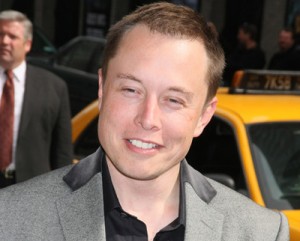With his Model S sedan winning raves for its cutting-edge battery powertrain technology, it’s no surprise that Tesla founder and CEO Elon Musk might want to be perceived as the leader in the development of another sci-fi to sci-fact technology: autonomous driving.
And the South African-born entrepreneur – who also runs aerospace firm SpaceX – suggests he’s going to leapfrog several other automakers who also are promoting self-driving cars. That includes Nissan, whose Leaf remains the world’s best-selling battery-electric vehicle, ahead of the Tesla Model S.
“We should be able to do 90% of miles driven within three years,” Musk says in an interview with the Financial Times. Translation: he doesn’t think the technology is there for a completely autonomous vehicle that can handle all roads under all conditions, something he calls “a bridge too far.”
Nonetheless, if Musk can get Tesla out there by 2016 or so with a car that can handle major highways and roads in good weather that would still position it well ahead of what even his most ambitious competitors have been calling for.
Nissan, for example, announced last month that it will be in production with a fully autonomous vehicle by sometime in 2020. General Motors’ Cadillac, Mercedes-Benz, BMW and others hope to have something similar in play by early in the next decade. So does Silicon Valley tech giant Google, which has been actively testing its own autonomous vehicle prototypes.
(Click Here for more on Nissan’s autonomous vehicle plans.)
Google officials don’t expect to build their own cars but hope to partner with some major manufacturer. It does not appear, however, that there’s anything going between Google and the also California-based Tesla.
What’s significant about Nissan’s earlier announcement is that the Japanese maker wants to offer its self-driving technology on an “affordable,” mainstream vehicle. While it has not identified which model that might be, speculation has focused on the little Leaf battery sedan – which sells for a fraction of the price of the Tesla Model S. That model can go up to more than $100,000 with an extended-range battery pack.
Tesla, however, has indicated it is working on several new models, starting with the Model X – a crossover-utility sharing the Model S platform – and a smaller, lower-priced electric vehicle that would come a bit closer to the Nissan Leaf’s price.
(Automakers “democratize” technology, offering luxury-level hi-tech features in mainstream models. Click Herefor more.)
As Japan’s second-largest automaker has demonstrated, the technical basics are rapidly falling into place. Even conventional vehicles now use an array of cameras, radar, sonar and laser sensors to let the latest safety systems keep on what’s happening nearby. And the price of those devices will continue to fall, experts predict, even as computing power continues its rapid increase.
Various prototypes now can be routinely seen on roads around the country, particularly in Nevada, the first state to create special licensing requirements for autonomous vehicles. But while Nissan really demonstrated a Leaf coping with simulated city and highway driving conditions, project co-director Maarten Sierhuis, a former NASA scientist, stresses that “We need to be able to drive any intersection anywhere and at any time to be fully autonomous.”
(What’s it like to drive…er, ride…er, co-pilot an autonomous vehicle? Click Here to find out.)
That helps explain Tesla’s more cautious strategy. In fact, autonomous driving proponents anticipate that for at least some years, someone will still be required to sit behind the steering wheel ready to assume command in a situation the vehicle can’t handle – perhaps in a winter white-out.
“It’s incredibly hard to get the last few percent,” cautions Musk
Nonetheless, the general consensus is that autonomous vehicles should be able to improve highway safety, reduce fuel consumption and emissions, and even improve utilization of roadways by allowing such cars to convoy, driving in packs mere feet from each other’s bumpers.
One of the big issues all makers are fretting about is liability. Despite the potential to save lives and reduce fender-benders, there is a well-founded fear that in the U.S., in particular, any accident involving an autonomous vehicle could wind up being blamed on the technology.
That led Nissan’s global product development chief Andy Palmer to tell TheDetroitBureau.com that the Japanese maker might introduce its first autonomous vehicle in a less litigious country and wait until it gets some relief from American lawmakers and regulators.


This is slightly off-topic, but is there only ONE stock photo of Elon Musk?
LOL…we DO need more…but the Tesla media site is an awful image resource.
How about Google Images? I see mucho.
You have to get permission to use images, Sidney, before you can lift them from GoogleImages.com, I’m afraid. But we WILL try to get some new shots of Elon.
Paul E.